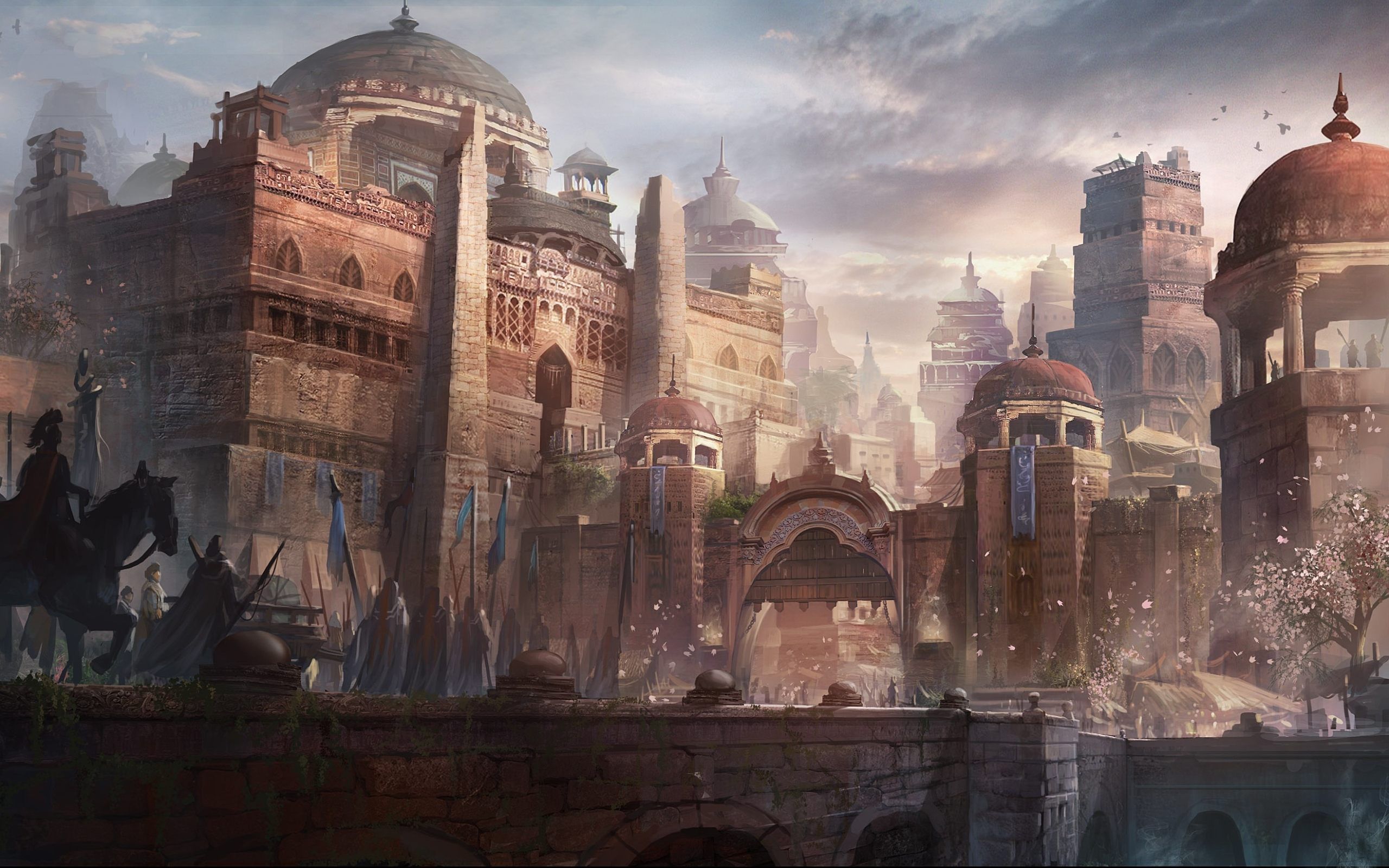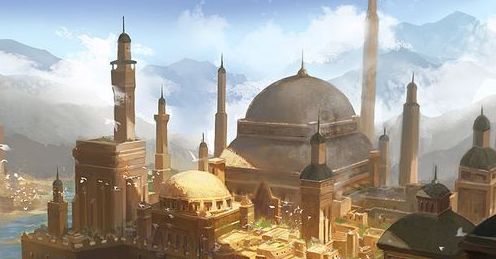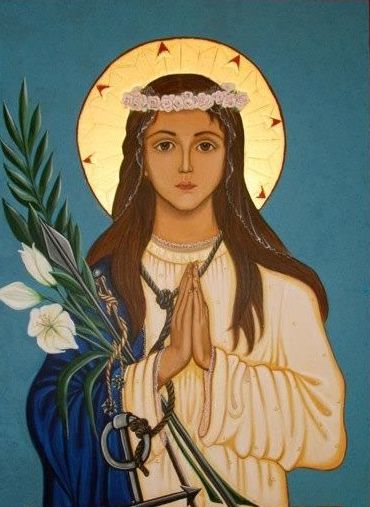Komneia
One of the largest cities in the world, a splendid beauty sheltering the Rasennan past and the capital of the Principality that bears its name
Defences
Very few cities can boast the defenses that Komneia has, the long moat protects much of the city from three corners but the walls are among the most impressive in the known world. Situated at the northern end of the city limits, the Macerian Wall, built by the famous Rasennan emperor is a marvel of ancient engineering and rises higher than any walls built after the Dykairos. The wall reaches 60 feet into the sky and the main battlement is some 12 meters thick. The Macerian has thrown back besiegers from all corners of the known world and protected the vital chokepoint that was Komenia during the imperial age. Certain towers on the wall hold significance for their importance during a siege, the Rhesion tower is the central and largest watchtower and is the seat of command for the city's defending leader. The tower was apparently crudely constructed by Maurice Vatatzes during the 21 A.E siege of the city and reinforced in later years with stone. The Macerian holds several key gates into the city, these gates have seen their share of intense fighting but also hold significance in imperial parades, coronations, burials, and triumphs. The Spring Gate served as the famous starting point of Maurice Vatatzes' triumph through the city in celebration of the successful defense of the city from Khan Turvil.
History
Founded as a settlement by Agrihenian pirates sometime in the Archaic past, the site of Komneia has been of vital importance in controlling the upper Arnziatic gulf for centuries. When the coast of Agrihenia was taken during the reign of Emperor Marian, the site was a key fortified town that held a garrison and was the seat of provincial governors for a time. Later, the city would be refounded by Emperor Aurakios who holds special significance in the city's history as he also constructed many of the old landmarks the city still boasts of. Komenia as it was renamed, is a name coming from the bending of the river Propone into an old wheat field that was called Komenene.
Now given a proper Rasennan founding, Komenia quickly grew in importance due to its importance in Agrihenia which was becoming the empire's primary recruiting ground for seasoned soldiers. Komenia benefited as a crossroad of trade and commerce in the Arnziatc as it led to the eastern markets of the Ivanshar and the rest of the empire. Komenia also served as a point of strength positioned near the Oltune frontier and so was a mustering location for armies looking to campaign across the river or to defend Agrihenia from foreign incursion. Overall, the city saw many uses throughout its time of imperial service and grew rich and wealthy from its connection to the other cities of the empire and from its key geographic significance. When the empire fell, Komneia became a refuge for citizens in Agrihenia and beyond to come to and seek shelter and safety as Lakia fell and much of Agrihenia itself followed suit after the Yarmeza stormed beyond the river. Khan Turvil, the dreaded destroyer of imperial cities mustered a host and attacked the city but was thrown back by Maurice Vatatzes, a veteran commander who had also seen the fall of Rasca some twenty years prior. Under Maurice, Komenia survived the initial onslaught of the Dykairos and via a more democratic system of Princely elections, it regained its strength and prestige centuries after the fall of the empire. Komenia today is perhaps the greatest city in the world, an ancient seat of power to a state claiming descent from the great empire that built their capital.
Now given a proper Rasennan founding, Komenia quickly grew in importance due to its importance in Agrihenia which was becoming the empire's primary recruiting ground for seasoned soldiers. Komenia benefited as a crossroad of trade and commerce in the Arnziatc as it led to the eastern markets of the Ivanshar and the rest of the empire. Komenia also served as a point of strength positioned near the Oltune frontier and so was a mustering location for armies looking to campaign across the river or to defend Agrihenia from foreign incursion. Overall, the city saw many uses throughout its time of imperial service and grew rich and wealthy from its connection to the other cities of the empire and from its key geographic significance. When the empire fell, Komneia became a refuge for citizens in Agrihenia and beyond to come to and seek shelter and safety as Lakia fell and much of Agrihenia itself followed suit after the Yarmeza stormed beyond the river. Khan Turvil, the dreaded destroyer of imperial cities mustered a host and attacked the city but was thrown back by Maurice Vatatzes, a veteran commander who had also seen the fall of Rasca some twenty years prior. Under Maurice, Komenia survived the initial onslaught of the Dykairos and via a more democratic system of Princely elections, it regained its strength and prestige centuries after the fall of the empire. Komenia today is perhaps the greatest city in the world, an ancient seat of power to a state claiming descent from the great empire that built their capital.
Points of interest
Komenia being the large city that it is has dozens of locations with great value as tourist destinations, pilgrimage sites, and other storied locations within its walls. The Milion, is the marker of the center of the city and for distance across the principality. The Doukain Vaults are tombs with a long history going back to the Doukain emperors Crispus and Makerios who are both thought to be buried there. The vaults display ecclesia imagery along with equestrian statues of the emperors Darius and Julius Dicorus. The Purple Palace is the seat of the Princes and Princesses of the state, built by Emperor Aurakios, the palace is a sight to see with its Natreshan purple facade, large keystone arches, and enormous interior. The Purple Palace has gone through many iterations and seen many uses as initially, it was the seat of the imperial heir, in contrast to the red room of the imperial palace in Rasca. As Komneia grew in wealth and significance, the Purple Palace became a favored destination for the emperor to reside when on campaign in Agrihenia. The Palace served as a special meeting place for foreign dignitaries as they would be wowed by the palace's enormity and splendor. During the centuries of decline, the palace's large interior ballrooms were used as barracks for imperial retinues and retainers and some of the more elaborate statues were broken apart and the precious metals were melted down into coins. With the saving of the city by Maurice in 21 A.E, the city largely survived the uglier and more violent sides of the coming Dykairos as the Princes hid behind the land wall while the surrounding countryside was ravaged by all manner of ills.
Tourism
Many from around the world flock to the majestic Queen of Cities, Komenia is unlike any city in the world as it holds the cradle of Rasennan civilization tightly behind its walls and its armies. The many locations of majesty, from the Purple Palace, the shrine of Blessed Sestaia, and the mighty and imposing Macerian land wall.
Architecture
The city preserves ancient Rasennan building styles and incorporates them into a skyline that is only found here. Inside the city sit dozens of locations with long histories, for example, the important site of the Milion, a large tetrapylon marking the center of the city, and the basis of measurement of distance for the Komenians.
Maintainance of the infrastructure of the capital at Komneia is well attested before 707 A.E. The Kirean Cisterns, those built by the urban prefect Kires in the 1st-century B.E are the three largest sources of fresh water for the city and measure approximately 500 by 300 feet and are capable of holding 2,800,000- 3 million cubic feet of water. These cisterns mainly collect rainwater and water from the Propona which flows through the city for most of the year.
The centerpiece of the city of Komneia is without a doubt the "Ekklisía tis Agías Anáktisis kai tis Aftokratorikís Anakaínisis" or Church of the Holy Recovery and of the Imperial Renovation. Built over the course of the reign of Emperor Aurakios, the great cathedral as it is known today was consecrated by the famed Emperor Roman the VasilaiósAgías Anáktisis as it is known is the holiest site in the city and is home to an itinerary of collected relics and artifacts from the city's past as well as the older Rasennan past.
Maintainance of the infrastructure of the capital at Komneia is well attested before 707 A.E. The Kirean Cisterns, those built by the urban prefect Kires in the 1st-century B.E are the three largest sources of fresh water for the city and measure approximately 500 by 300 feet and are capable of holding 2,800,000- 3 million cubic feet of water. These cisterns mainly collect rainwater and water from the Propona which flows through the city for most of the year.
The centerpiece of the city of Komneia is without a doubt the "Ekklisía tis Agías Anáktisis kai tis Aftokratorikís Anakaínisis" or Church of the Holy Recovery and of the Imperial Renovation. Built over the course of the reign of Emperor Aurakios, the great cathedral as it is known today was consecrated by the famed Emperor Roman the VasilaiósAgías Anáktisis as it is known is the holiest site in the city and is home to an itinerary of collected relics and artifacts from the city's past as well as the older Rasennan past.
Geography
Located in the swampy terrain of coastal Agrihenia, Komenia has thanked the land around it for numerous failed sieges as the area around it is an effective moat against enemies. The swamps of Komenia mean that effectively it is surrounded on three sides by water making a land approach to the city the only viable way of getting into the city without a boat. Inside the city, the terrain is generally quite flat, with a few hills dotting the area. A small stream runs through the city and into the gulf, this stream, the Propona dries up for portions of the year but is a reliable source of drinking water for the population during the spring.
Founding Date
680 B.E
Founders
Alternative Name(s)
The Marble City, The City
Type
Large city
Population
~800,000
Inhabitant Demonym
Komneian
Location under
Included Locations
Owner/Ruler
Ruling/Owning Rank
Owning Organization
Related Tradition (Primary)
(The extensive Kirean Cisterns which help give the nearly 500,000 citizens of Komneia drinking water)
(The Macerian Land Wall, the guardian of the city and withstander of numerous sieges and assaults)







Comments